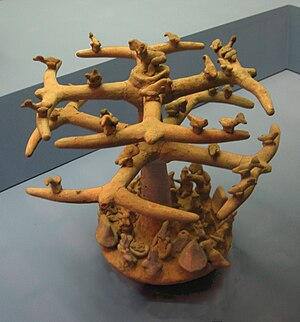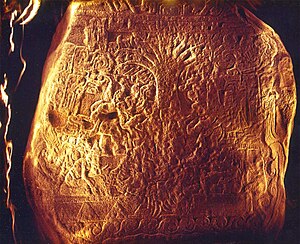



World trees are a prevalent motif occurring in the mythical cosmologies, creation accounts, and iconographies of the pre-Columbian cultures of Mesoamerica. In the Mesoamerican context, world trees embodied the four cardinal directions, which also serve to represent the fourfold nature of a central world tree, a symbolic axis mundi that connects the planes of the Underworld and the sky with that of the terrestrial realm.
Depictions of world trees, both in their directional and central aspects, are found in the art and mythological traditions of cultures such as the Maya, Aztec, Izapan, Mixtec, Olmec, and others, dating to at least the Mid/Late Formative periods of Mesoamerican chronology. Among the Maya, the central world tree was conceived as or represented by a ceiba tree and is known variously as a wacah chan[pronunciation?]oryax imix che[pronunciation?], depending on the Mayan language.[3] The trunk of the tree could also be represented by an upright caiman, whose skin evokes the tree's spiny trunk.[4]
Directional world trees are also associated with the four Yearbearers in Mesoamerican calendars, and the directional colors and deities. Mesoamerican codices which have this association outlined include the Dresden, Borgia, and Fejérváry-Mayer codices.[5] It is supposed that Mesoamerican sites and ceremonial centers frequently had actual trees planted at each of the four cardinal directions, representing the quadripartite concept.[citation needed]
Izapa Stela 5 is considered a possible representation of a World Tree, as is the tree on Kʼinich Janaabʼ Pakal's sarcophagus at Palenque.[6]
World trees are frequently depicted with birds in their branches, and their roots extending into earth or water (sometimes atop a "water-monster", symbolic of the underworld).
The central world tree has also been interpreted as a representation of the band of the Milky Way.[7]
While the cosmic tree symbolism has deep roots in Mesoamerican cultures,[8] the precise botanical identification and underlying meaning of the motif remain poorly understood. Attempts have been made to identify the tree as a kapok, maize, or water lily, with the latter being a particularly prominent interpretation based on archaeological evidence from sites like San Bartolo.The frequent personification of gods and rulers as manifestations of the world tree underscores its crucial symbolic and ritualistic significance in Mayan religion and kingship.